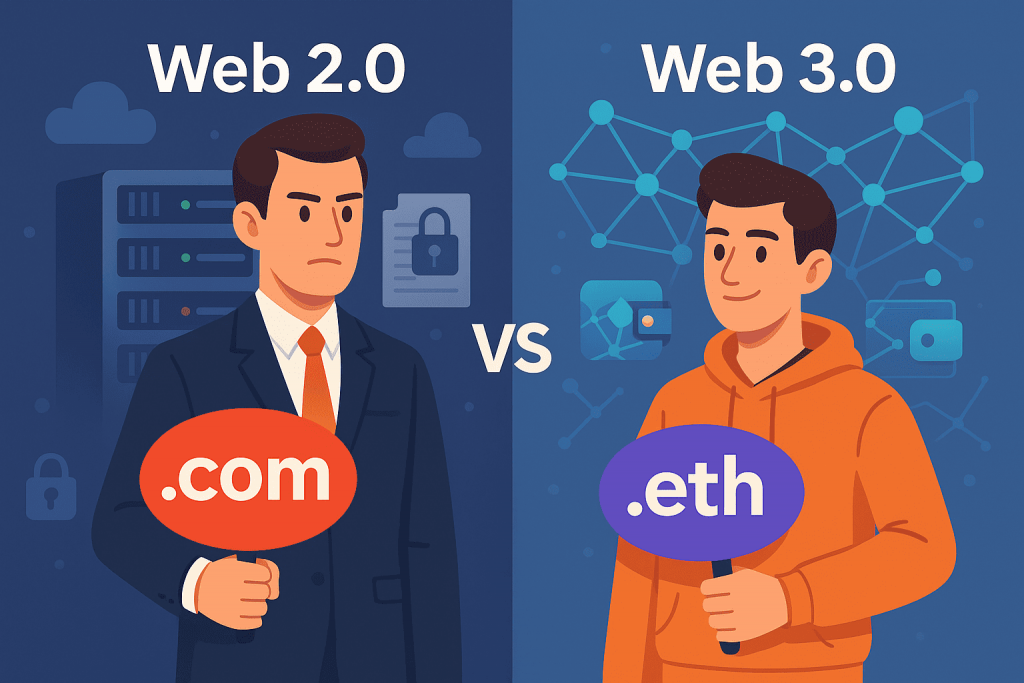
The internet is evolving rapidly. We’ve already lived through Web 1.0 — static pages, Web 2.0 — dynamic services and social media, and we’re now entering the Web 3.0 era — a time of decentralization, blockchain, transparency, and user control over personal data. Domain names are evolving too.
The emergence of Web 3.0 domains marks a major milestone: they reshape how we perceive digital identity, ownership, and online independence. In this article, we’ll break down how Web 3.0 domains differ from traditional ones — and when it makes sense to use each.
What Are Web 3.0 Domains?
Web 3.0 domains are blockchain-based domain names. Unlike traditional domains that rely on centralized DNS and registrars, Web3 domains are stored in the blockchain as NFTs (non-fungible tokens) and owned via a crypto wallet.
Popular Web 3.0 extensions include:
- .eth — via Ethereum Name Service (ENS);
- .crypto, .nft, .dao — from Unstoppable Domains;
- .zil — on the Zilliqa blockchain.
Web 3.0 domains can serve as:
- website addresses;
- cryptocurrency wallets;
- unique user IDs across Web3 apps;
- digital business cards that cannot be forged.
Key Differences Between Web 2.0 and Web 3.0 Domains
| Feature | Traditional Domains (Web 2.0) | Web 3.0 Domains |
| Registration | Through domain registrars | Through crypto wallets or NFT platforms |
| Control | Managed by registrars, ICANN | Fully owned by the user via private keys |
| Censorship | Can be blocked or taken down | Censorship-resistant without private key access |
| Payment | Yearly renewal fees | Usually one-time payment |
| Renewal | Required annually | Not required |
| Hosting | On traditional hosting servers | On decentralized storage (IPFS, Filecoin) |
| SSL Certificate | Needed for HTTPS (order here) | Often not required — encryption is built-in |
| Browser Support | Fully supported | Limited — requires browser plugins or Web3 browsers |
| Target Audience | Businesses, government, eCommerce | Crypto, NFT, DeFi, DAOs |
1. True Ownership Without Intermediaries
With traditional domains, even if you’ve paid for 10 years, you’re technically renting. A registrar can suspend, revoke, or transfer your domain due to complaints, legal issues, or regulations.
In Web 3.0, your domain is stored in your crypto wallet like an NFT — you fully own it, and no authority can touch it without your private key. This is especially useful for high-risk content, activism, or crypto projects.
2. One-Time Payment, Lifetime Use
Traditional domains require yearly renewal. If you forget to renew, your domain may be lost or snatched by a competitor.
Web3 domains offer a buy-once-use-forever model. No renewal fees, no hidden costs. Once minted, your domain remains yours as long as you hold the wallet.
3. Your Web3 Identity
A Web3 domain is more than a website name — it’s your decentralized digital identity. You can use it as:
- your public crypto address (ivan.eth instead of 0x18e3…91A2);
- a login for Web3 platforms;
- a signature for transactions;
- a unified profile in the metaverse or DAO ecosystems.
It becomes your brand in the decentralized world.
4. Censorship Resistance
Traditional domains can be blocked by DNS providers, governments, or courts. In some countries, even legal content can become inaccessible.
Web 3.0 domains are hosted on IPFS and decentralized storage, which means your website stays online regardless of external interference — as long as users are connected to the network.
5. Limitations and Barriers
Despite their advantages, Web3 domains haven’t gone mainstream yet due to:
- lack of native support in traditional browsers (plugins or Web3 browsers like Brave are needed);
- technical knowledge required to configure wallets and DNS records;
- limited use in traditional commerce and business websites.
That’s why classic domains remain the foundation for most companies and organizations.
6. Hosting, Servers, and Infrastructure
Even with a Web3 domain, you may still need:
- hosting for redirects or gateway access;
- backend on a VPS server for Web2 interactions;
- SSL certificates if you integrate traditional components.
In many cases, hybrid setups — combining Web3 domains with reliable RX-NAME hosting solutions — offer the best of both worlds.
What Should You Choose: Web 2.0 or Web 3.0?
| If you are… | Choose… |
| Launching a business or eCommerce website | Traditional domain + hosting + SSL |
| Building a crypto or Web3 startup | Web3 domain for decentralized identity |
| Developing a blog or influencer profile in Web3 | Web3 domain as your unique online brand |
| Creating a DAO or NFT platform | Web3 domain for branding and wallet integration |
Final Thoughts
Web 3.0 domains represent the future of the decentralized internet — full ownership, censorship resistance, and blockchain-native identity. But traditional domains remain the most accessible and reliable option today:
- full compatibility with browsers;
- support for SSL certificates;
- powerful server rental and colocation options;
- excellent for business, government, and high-performance web projects.
Choose what fits your project best — and rely on RX-NAME for the infrastructure that makes it work.

Leave a Reply